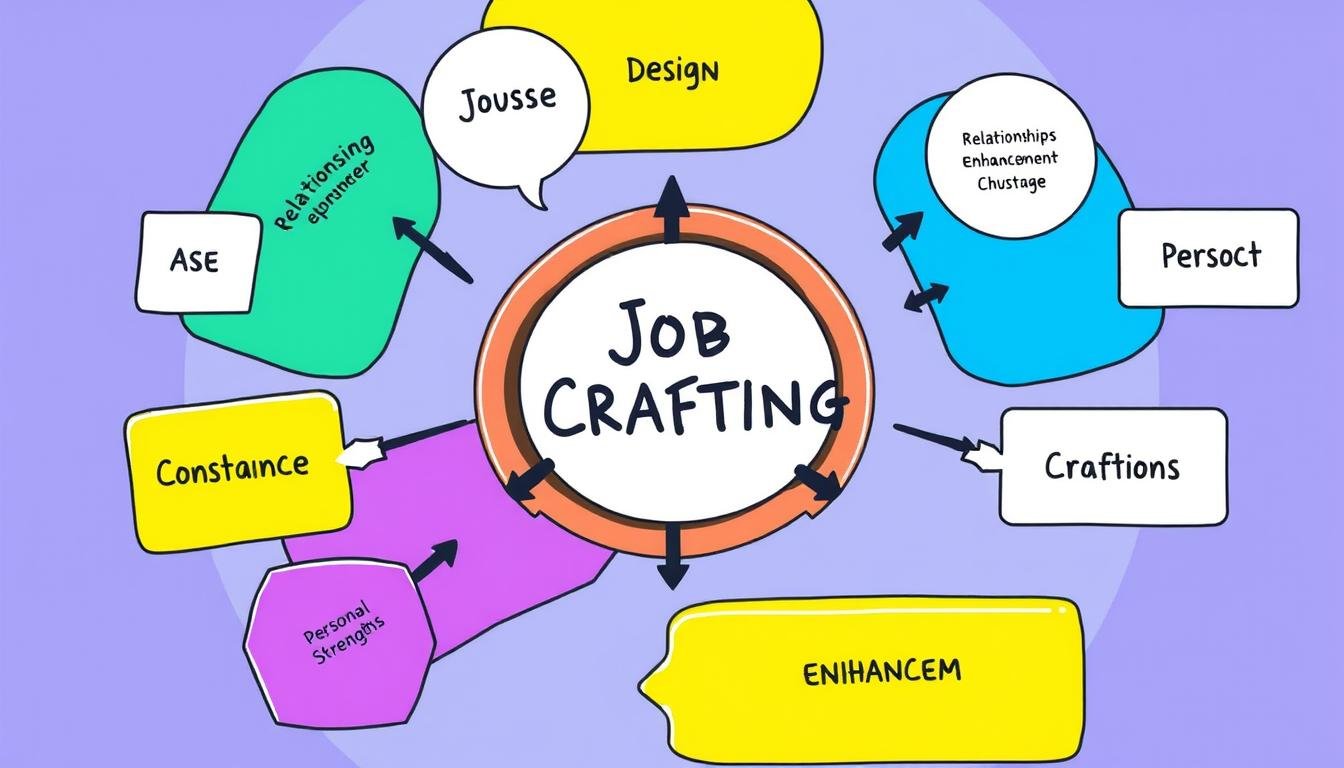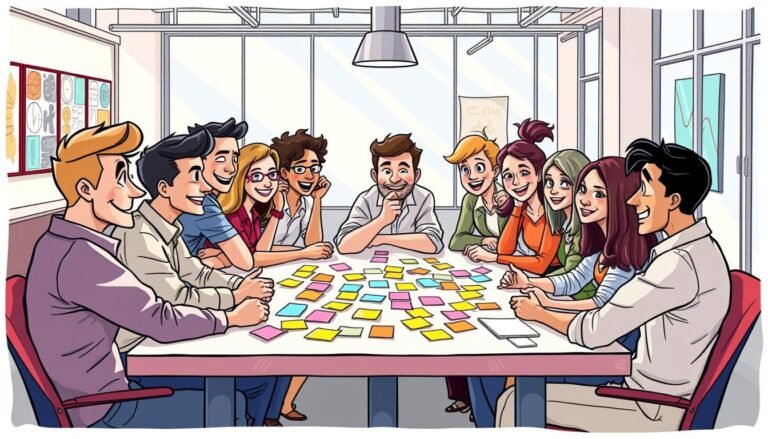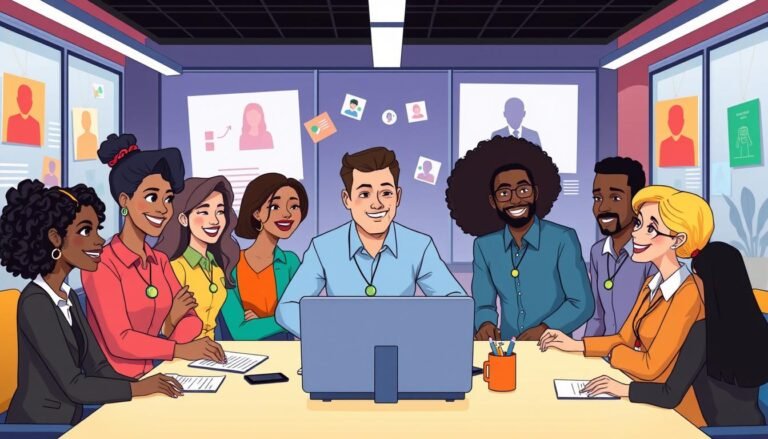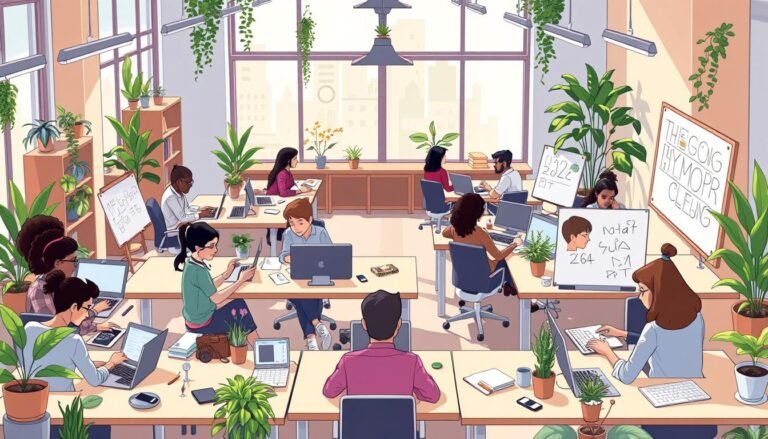Job Crafting: How Psychology Can Help You Shape Roles for Success
Ever thought about changing your job to fit your skills and passions better? Job crafting, based on workplace psychology, lets you do just that. It’s a way to shape your role, making your job more satisfying and engaging.
In today’s fast-changing work world, being able to shape your role is key. We spend a lot of time at work, so it’s important to make it fulfilling. Job crafting helps you redesign your job to match your strengths and interests.
By using job crafting, you can change your work experience. This means altering tasks, who you work with, and how you see your job. It’s not just small tweaks; it’s a big change in how you do your job.
Job crafting boosts performance, motivation, and engagement. It’s different from traditional job design, which is often top-down. With job crafting, employees take charge of their own work changes.
Key Takeaways
- Job crafting empowers employees to reshape their work roles
- It involves changing tasks, relationships, and job perceptions
- Job crafting leads to better performance and motivation
- It differs from traditional job design by being employee-driven
- Understanding workplace psychology is crucial for effective job crafting
Understanding Job Crafting
Job crafting lets employees change their jobs to fit their skills and interests. It’s a big deal in organizational psychology. It helps people enjoy their work more and feel happier.
Definition and Core Concepts
Job crafting means making your job better by changing what you do, who you work with, and how you see your job. It’s a way for employees to take charge of their work. It works alongside the usual way jobs are designed.
Origins in Organizational Psychology
Job crafting started in research on how people work. It’s based on old ideas about designing jobs. But it focuses on how employees can make their jobs their own.
Key Components of Job Crafting
Job crafting has three main parts:
- Task Crafting: Changing job tasks to match your skills and interests
- Relational Crafting: Making and improving work relationships
- Cognitive Crafting: Changing how you see your job’s meaning and impact
| Component | Description | Impact on Work Engagement |
|---|---|---|
| Task Crafting | Changing job tasks to fit your skills and interests | Makes you happier and more productive |
| Relational Crafting | Improving work relationships | Helps you work better together |
| Cognitive Crafting | Changing how you see your job | Makes you more motivated and purposeful |
More than 70% of workers want to make their jobs fit their personal goals. This can make them more engaged, productive, and likely to stay with their company.
“Job crafting allows employees to customize their roles, leading to enhanced job satisfaction and work engagement.”
The Psychology Behind Job Crafting
Job crafting is based on important psychological theories. These theories explain why people are motivated and satisfied at work. They focus on needs like autonomy, competence, and relatedness. They also look at job design factors like variety and feedback.
A study with 340 Brazilian professionals showed interesting findings. It found that autonomy and the chance to craft jobs are key to meaningful work. Cognitive crafting, one of the main strategies, had the biggest impact on feeling fulfilled at work.
Job crafting means making your job more enjoyable and meaningful. It has become popular over the last 20 years. It shows how people can improve their work experience. The job demands-resource theory helps understand how this happens, looking at both job demands and resources.
| Job Crafting Strategy | Description | Impact |
|---|---|---|
| Task Crafting | Modifying job tasks and responsibilities | Increases job satisfaction and engagement |
| Cognitive Crafting | Reframing job perception and mindset | Strongest influence on meaningful work |
| Relational Crafting | Altering workplace relationships and interactions | Enhances sense of belonging and collaboration |
Studies show job crafting is easier for those with more autonomy or supportive leaders. This shows how important the work culture is. While job crafting is praised in HR and counseling, we must think about its limits. These include power issues and economic factors.
Job Crafting Techniques
Job crafting is a great way to make work better fit and more satisfying. It lets employees shape their jobs to match their skills and interests. Let’s look at three main ways to customize jobs.
Task Crafting
Task crafting means changing what you do at work. You can add, remove, or change tasks to fit your skills and interests. This might mean starting new projects or handing off tasks you don’t enjoy.
Relational Crafting
Relational crafting is about improving how you work with others. It’s about changing how you interact with colleagues, clients, or bosses. This could mean finding a mentor or working with new team members.
Cognitive Crafting
Cognitive crafting is about seeing your job in a new light. It’s about understanding how your tasks fit into a bigger picture. This change in thinking can make you happier and more motivated at work.
| Technique | Action | Benefit |
|---|---|---|
| Task Crafting | Redesigning tasks | Improved skill utilization |
| Relational Crafting | Building new relationships | Enhanced collaboration |
| Cognitive Crafting | Reframing job perceptions | Increased job satisfaction |
Using these techniques, employees can make their jobs more rewarding. Job crafting lets people take control of their work life. This leads to more engagement and productivity.
Benefits of Job Crafting
Job crafting brings many benefits for both employees and companies. It makes work better, leading to happier workers and better performance. Let’s look at the main advantages of job crafting.
Happy workers are 12% more productive, research finds. Job crafting is key to making employees happy. It lets workers shape their jobs, making them more engaged and committed to their company.
It also helps prevent burnout, a big issue for employee health. Job crafting lowers stress at work, making the workplace healthier. This is crucial since heart disease and stroke, linked to work stress, are among the top health costs for employers.
| Benefit | Impact |
|---|---|
| Increased Productivity | 12% boost in productivity among happy employees |
| Stress Reduction | 29% decrease in stress levels post-pandemic |
| Job Satisfaction | 92% of participants reported more satisfying work life |
| Employee Retention | Reduced talent turnover and increased loyalty |
Employers see better productivity with job crafting. It also keeps employees from leaving, making them more loyal. In fact, 92% of those who tried job crafting said they were happier at work and more satisfied personally.
“Job crafting is a powerful tool for enhancing employee well-being and organizational success. It empowers workers to align their roles with their strengths and passions, leading to improved job satisfaction and performance.”
Job Crafting and Employee Engagement
Job crafting is key to boosting employee engagement. It lets people shape their roles, making work more fulfilling. This leads to more motivation and satisfaction at work.
Enhancing Motivation
When employees craft their jobs, they match tasks with their skills and interests. This boosts motivation. A study of over 1,000 employees showed job crafting increases work engagement.
Those who take on more challenges and resources through job crafting feel more engaged.
Boosting Job Satisfaction
Job crafting greatly affects job satisfaction. Research shows it’s linked to personal growth and satisfaction. A study of 279 employees found job crafting boosts career satisfaction.
Improving Work-Life Balance
Job crafting helps achieve a better work-life balance. By customizing their roles, employees can balance work and personal life better. This reduces stress and improves overall well-being.
| Job Crafting Element | Impact on Engagement |
|---|---|
| Increasing structural resources | Higher work engagement |
| Taking on extra tasks | Increased engagement |
| Crafting for personal growth | Higher job satisfaction |
| Balancing demands and resources | Better work-life integration |
By embracing job crafting, organizations can create a more engaged workforce. This approach improves individual performance and helps the organization succeed.
Overcoming Challenges in Job Crafting
Job crafting is a great way to adapt to the workplace, but it comes with its own set of challenges. Employees often face obstacles that make it hard to change their roles. These include organizational constraints and barriers to job crafting.
One big challenge is the lack of control in some jobs. When you can’t decide what you do or when, it’s tough to make changes. This is especially true in jobs with strict rules or regulations.
Another big hurdle is when managers don’t support job crafting. They might see it as a risk to their plans or worry it could upset the team. It’s important to talk openly about why job crafting is good.
“Job crafting provides relief from burnout by exploring relationships, tasks, and cognitive framing of work.”
Finding the right balance between personal and work goals is hard. You need to make sure your new role still fits with the company’s aims. It’s all about finding a balance between growing personally and meeting work needs.
| Challenge | Solution |
|---|---|
| Lack of autonomy | Gradual implementation of small changes |
| Management resistance | Open dialogue about job crafting benefits |
| Balancing individual and organizational goals | Regular check-ins with supervisors |
To tackle these issues, start by asking yourself about your job. Think about your relationships, tasks, and how you see your work. This helps you find where job crafting can really make a difference, while still respecting your job’s rules.
Job Crafting in Different Work Environments
Job crafting looks different in every workplace. Whether it’s remote work, traditional offices, or flexible setups, people find creative ways to make their jobs their own.
Remote Work Settings
Remote workers enjoy more freedom to shape their tasks. A study in the Netherlands found that those who love their jobs tend to craft more. They can set their own hours, create the perfect workspace, and use tech to get more done.
Traditional Office Environments
In offices, job crafting means building better relationships with coworkers. You can mentor others, join teams across departments, or help out in new ways. Studies show that how you craft your job affects how happy you are at work.
Flexible Work Arrangements
Flexible work mixes the best of both worlds. You can pick your hours, where you work, and how you balance work and life. This setup makes people happier and more productive at work.
| Work Environment | Job Crafting Opportunities | Challenges |
|---|---|---|
| Remote Work | Schedule flexibility, personalized workspace | Maintaining work-life boundaries |
| Office Environment | Face-to-face collaboration, mentoring | Limited physical workspace customization |
| Flexible Arrangements | Balancing remote and office benefits | Coordinating with team members |
Job crafting is key in any workplace to make jobs better and more engaging. Employers can help by letting employees shape their jobs, making them part of big decisions, and valuing both work and play. This makes everyone feel more connected and valued.
Implementing Job Crafting Strategies
Job crafting changes how companies work. They need to be flexible and give employees freedom. This fits with today’s work trends, where people want meaningful jobs over just career steps.
Job crafting brings big wins. Companies see a 30% boost in productivity when employees shape their jobs. Innovation jumps by 20% compared to strict job roles. These numbers show how job crafting can change a company for the better.
To make job crafting work, follow these steps:
- Give employees the tools and training they need to change their roles
- Help them craft tasks to make their jobs more satisfying by 15%
- Support teamwork by 10% through relational crafting
- Boost the meaning of work by 12% through cognitive crafting
Google’s 20% time policy is a great example. It lets employees work on side projects, leading to big ideas. This shows how job crafting can help both employees and the company grow.
But, job crafting needs careful handling. It’s important to balance freedom with keeping things aligned with the company’s goals. With the right approach, job crafting can make the workplace better, leading to a happier, more productive team.
The Role of Management in Facilitating Job Crafting
Management support is key to job crafting in organizations. A study with 1,000 leaders and 2,000 workers worldwide shows its importance. It’s especially true for Gen Y and Z, who want to do meaningful work.
Creating a Supportive Culture
It’s important to have a culture that supports job crafting. Leaders can do this by:
- Recognizing and rewarding new work ideas
- Encouraging open talks about job roles
- Helping employees grow and learn
Providing Resources and Tools
Managers need to give employees the right tools for job crafting. This includes:
- Training on job crafting methods
- Mentorship chances
- Online tools for teamwork and learning
Balancing Organizational Goals with Individual Needs
Managers face the challenge of matching job crafting with company goals. A study with 480 employees and their bosses found job crafting boosts creativity. This is more true for those with higher job status.
By embracing job crafting, managers can make employees happier and more fulfilled. This approach is especially useful in today’s AI and changing work world.
Conclusion
Job crafting is good for both workers and companies. It makes workplaces more innovative and lets employees make changes. This leads to happier and more productive workers.
By changing their work, people find more meaning in their jobs. This is thanks to three main parts of job crafting: task, cognitive, and relational. These parts help workers feel in control and connected.
This approach makes teams more motivated and engaged. It’s important for companies to succeed. Studies also show it helps reduce stress and burnout from routine jobs.
There are many examples of job crafting success. For instance, janitors who take on more tasks feel happier. Companies that support job crafting see better employee engagement and retention.
As work changes, supporting job crafting becomes crucial. It helps attract and keep talented employees. This way, workplaces can become places where creativity and connection thrive.
Source Links
- What is Job Crafting? (Incl. 5 Examples and Exercises)
- Finding Fulfillment at Work: The Psychology of Job Crafting
- From the Department of OR the Center for OR the Institute for
- Job Crafting Unveiled: A Roadmap to Top-Performer Loyalty and Long-Term Triumph
- Job Crafting and Work Engagement: The Mediating Role of Work Meaning
- Basic Psychological Need Satisfaction, Job Crafting, and Meaningful Work: Network Analysis
- Can workers really craft their own happiness in the job?
- Four Tips For Job Crafting: A Tool For NeuroInclusion
- Job Crafting: What HR Professionals Need to Know
- What are the different types of job crafting? — Tailored Thinking | Make Work Better, Make Better Work
- Could Job Crafting Be A Powerful Tool For Employee Wellness?
- What is Job Crafting? Benefits and Examples of Job Crafting | ELI
- How Job Crafting Can Make Work More Satisfying
- Impact of Job Crafting and Employee Personality on Work Engagement and Perceived Career Satisfaction
- Frontiers | The consequences of job crafting and engagement in the relationship between passion for work and individual performance of Portuguese workers
- Frontiers | Balancing Work Life: Job Crafting, Work Engagement, and Workaholism in the Finnish Public Sector
- Job Crafting: Reshaping Your Role to Overcome Burnout It’s Your Career Blog
- Job crafting, meaningful work and performance: a moderated mediation approach of presenteeism
- Interactions of Approach and Avoidance Job Crafting and Work Engagement: A Comparison between Employees Affected and Not Affected by Organizational Changes
- Job crafting and leisure crafting: creating meaning and fostering commitment to work – Global-Watch.com Network
- Job Crafting: definition, Types, and Implementation Guide – Shiftbase
- Job crafting interventions: what works, for whom, why, and in which contexts? Research protocol for a systematic review with coincidence analysis – Systematic Reviews
- The rise of job crafting in modern organizations – HRD
- Job Crafting
- Strengths-Based Job Crafting and Employee Creativity: The Role of Job Self-Efficacy and Workplace Status
- Job Crafting: Unleash Your Employees’ Inner Superhero at Work!
- Burning Out? Ever Heard of Job Crafting?







